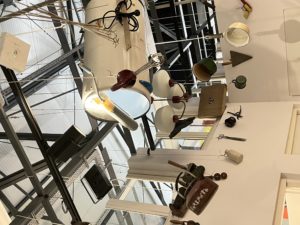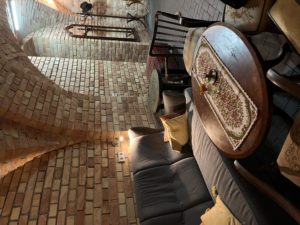Democracy Idealized Through Dinnerware: Small Objects Tell a Much Larger Story
By Abigail Wright
In the final stretch of our visit to Birkenau, former Nazi concentration and extermination camp, we knelt down and beheld the natural unearthing of history, of a story that could fit in the palm of our hands. At ground level, rusted silverware and charred pots piled into a glass enclosure with other household items scattered across the top—salt shakers, broken fragments of ceramic dishes, more spoons, little buttons and thimbles. A topographical map, of sorts, of the small belongings that outlasted their owners.
Glass mixed with the gravel below, pops of colored edges peeking through the dirt. I palmed a small piece of red and tried to place the peculiar feeling of my own hands meeting the fingerprints of one of the 6 million murdered Jews, the significance of such a small thing telling such a big story.
Positioned just yards away from former gas chambers and crematoriums, these little items represented just a small fraction of the stolen Jewish property at the hands of Nazis, all collected in massive storage facilities known as Effektenlager, or Kanada. Coined “The Land of the Plenty,” Jewish prisoners who weren’t immediately gassed upon arrival were tasked with sorting through these belongings, deeming what was ‘valuable’ enough to sell in order to further support the war effort. The rest remained in Kanada or burned.
This mass plundering represents the ‘end’ of a brutal story: mass discrimination and displacement of minority groups (mainly Jews), piling massive amounts of people under the ground, onto trains, in desolate labor camps and eventually gas chambers. All along, these people were inching closer and closer to their death, unaware or simply refusing to believe that their lives would soon end. And wherever they came from, they had been living under a totalitarian regime since the early 1930s; if they were living in Poland, they were removed from their homes and forced into ghettos, and then concentration and death camps.
These families, these people, had been systematically robbed for years—nearing an unknown death, they packed whatever was left: dinnerware.
Knees to the ground, hands meeting little buttons and thimbles, it was just the ‘leftovers’ that remained; little things with seemingly no inherent value, nothing meaningful enough to steal or sell. Something as small as a spoon was representative of the innate need for personhood, or perhaps the woman’s instinct to provide safety, warmth, and food for her family.
Taking a closer look at the remnants of Kanada, I envisioned each object on a little table tucked away in a crowded home, five families per room. Or perhaps in a ghetto, bathed in a white tablecloth and set by a mother or a child. I thought about these families gathered around the table, passing around these little dishes and cups, forks and knives clinking against each other. I thought about those same families shoving those same dishes under the false pretense of ‘resettlement,’ a calculated manipulation tactic, a lie to lure people to their imminent murder.
Through my confrontation with these small objects in Auschwitz, I began to rethink the kitchen table as a complex being, an extended metaphor for the larger political landscape of the early stages of Nazism to the rise of Communism in 1945—two extremely oppressive, back-to-back histories.
During the Holocaust, the kitchen table represented this persistent, little thread of hope for survival in a period of mass genocide. The uncovered dinnerware in Birkenau tells an intricate story of resilience, of the unrelenting desire for safety—whether that be physically or a more spiritual, bodily feeling of warmth. Women, especially, chose to pack the household items that cultivated a safe space for their family, no matter where.
As time passed, marked by the burning of the camps, the crematoriums, the death of over 6 million Jews, the kitchen table manifested into a more complex being. During the repressive Communist regime immediately following, the kitchen table became a radical place of free speech in the private sphere. Democracy was actualized through dinnerware, the distance between tyrannic officials and ordinary people cultivating a clandestine space of liberty and power.
The concept of small spaces generating political power became a central thread in my own conjecture of the kitchen table for this era. I turned to sociologist Jeffrey Goldfarb, who further cultivated this idea in his book The Politics of Small Things: The Power of the Powerless in Dark Times. Theorizing the kitchen table and other small spaces, Goldfarb echoed and expanded upon my initial thoughts of small objects representing so much more than the space they take up. In the very beginning of his work, Goldfarb remarked that “…bonds of trust developed, enabling each individual who took part to forge an identity, a self, that was strikingly different from his or her institutionally defined persona. This was public life hidden in a private sphere,” (Goldfarb 15).
When I was crouched above the gravel, eye-level with the small objects that decorated the kitchen tables of the past, I couldn’t help but think of the identity of the women who handled these items, who beat on, despite.
Coming from a lineage of almost entirely women—just two chairs saved for the men at all my family gatherings—I felt a matriarchal connection with something smaller than one of my fingernails. There is an underrated importance to these broken pieces of ceramic, a representation of the woman’s persistent effort in providing for their families in the midst of terror. While the private sphere does allow for individual prosperity, as mentioned in Goldfarb’s work, there is more to this kitchen table than what meets the eye, mainly the lives of mothers and wives hidden beneath the surface.
In a chapter of How we Survived Communism and Even Laughed, a collection of essays detailing life in Communist Eastern Europe, journalist Slavenka Drakulic detailed three separate kitchens and the stories of the women who ruled them. Titled “The Language of Soup,” Drakulic interviewed three mothers and wives, listening as they unfurled their past as if unfolding dough, both sitting at the heart of the home: the kitchen table. She had only just met these women, and in telling the stories of their lives, they stumbled upon men—their discussions of “hard-core” politics around those very tables, the passiveness that accumulates in a space that offers little reprieve from the repressiveness of Communism. While not as physical of a battle compared to the Holocaust, this era was marked with similar shades of resistance, of a politicization of a very small thing.
Drakulic’s commentary about such a private, perhaps inherently lonely, sphere actualized the very fragmented ideas I had in Auschwitz—running thoughts of women, the kitchen, the meaning of small objects and their magnified presence. When one of the women, Daruta, explained her narrowing world, perhaps at the fault of the system in place or the men who enforce it, she said “when there is no space in society to express your individuality, the family becomes the only territory in which you can form it, exercise it, prove it, express it. But a family is too limiting,” (Drakulic 96). While her husband was also a victim of communism and the pressures of the system, Drakulic emphasized that his wife was a victim, too—she had to work to keep her family going, someone had to do it.
In a system that actively denies personhood, the sanctuary of the private kitchen offers a refuge, but has its limits. But the feeling of helplessness unites all of humanity in these kitchens—beyond gender, beyond individual sovereignty. The innate need for community, for shared conversations and interests and meals binds individuals together in the heart of the home; this private sphere, with all of its little items to represent the people that envelop it, is a unique act of defiance against communist rule.
While one little shard of glass cannot possibly tell the entire story, it offered a temporary seat at the table to unravel threads of personhood, the politics of small things, and the democracy of the private sphere.
When individuals and their stories perish at the hands of repressive systems, their relics persist, embalmed in the grounds where their owners took their last breaths.






